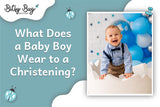Polyester vs Cotton For Baby
Babies have soft and sensitive skin, so choosing clothes for them can be challenging during parenthood. While there are various options on the market, not all fabrics have the same quality or are safe for babies. So, which is safer, polyester vs cotton for baby skin?
The baby's comfort and health are a priority for every parent, so their clothes must be safe, durable, breathable, and easy to clean.
So which materials to choose for your little one? If you are in doubt about whether to choose polyester vs cotton for baby clothes, keep on reading.

Source: shutterstock.com / Photo Contributor: Ellona Kritskaya
Polyester vs Cotton for Baby
When choosing clothes for the baby, it is recommended to choose an organic and natural fabric free of synthetic dyes and chemicals.
That said, the needs of your infant play a huge role in which material to choose. If your child has sensitive skin, it is best to opt for soft and natural materials such as cotton and organic cotton.
When your baby becomes more active, consider a durable and stretchable material such as cotton for easier movements. If you are searching for a durable fabric that won’t break over time, you can opt for polyester.
However, if you have concerns about the potential health risks which are often associated with this fabric, you can opt for natural fiber. Our newborn baby girl clothes collection is quite extensive when it comes to natural fiber and soft fabrics.
You can find products with these fabrics in different shapes, sizes, prices, colors and prints in the newborn girls' clothing boutique, which offers high-quality and stylish clothes made of such materials.
In case you are contemplating whether to choose polyester vs cotton for baby clothes, continue reading as we get into more details.
Cotton and organic cotton
Good qualities
- Lightweight
- Comfortable
- Durable
- Soft
- Breathable
- Biodegradable
- Moisture-wicking
Negative properties
- It has a tendency to wrinkle
- It can lose shape
- Risks damage from mildew
The cotton fabric is made from the cotton plant, and it is natural, crafted without any synthetic fibers.
It is a great choice for baby clothes, as the material is soft and it is breathable, providing comfort during different weather conditions. The fabric is highly absorbent, which means that it absorbs sweat and moisture easily.
Cotton is also hypoallergenic, resists abrasion, and doesn’t cause static electricity. Clothes made from cotton are also machine washable and can stand repeated washings.
However, the colors can fade very quickly, so make sure to wash such clothes carefully (turn them inside out before laundering) and as the manufacturer recommends.

Source: shutterstock.com / Photo Contributor: Africa Studio
Organic cotton
Organic cotton is much softer than conventional cotton and is grown with fewer chemical fertilizers. Hence, you can consider buying organic cotton if your little one has sensitive skin. This is because it is processed without any harsh chemicals, making it a great option for sensitive skin.
Organic cotton is also sustainable and environmentally friendly compared to other materials on the market.
The fibers of organic cotton are longer in comparison with regular cotton, and it is soft on the skin, which makes it a good option for babies.
During shopping, you can look for certifications for organic fibers such as OCS and GOTS. If the clothes are classified as USDA organic, it means that they are made with a minimum of 95% organic materials.
However, not all materials are 100% cotton, and many clothes are made from mixed material fabrics. If the product is labeled as standard 100 by OEKO - TEX, it means that the product is tested for unhealthy chemicals.
Polyester
Qualities
- Durable
- Water-resistant
- It doesn’t wrinkle easily
- It is more affordable than other fabrics
- It doesn’t easily get stretched out
- It is elastic and versatile
- The fabric dries very quickly
Negative properties
- The fabric is prone to static buildup
- It is less breathable than natural fiber
- Lacks breathability and moisture absorption
- It can hold onto odors
- The fabric is not biodegradable
Polyester is a common fabric for baby clothes. It is a synthetic fiber that is derived from petroleum. The fabric is easy to produce and, as a result, often affordable.
However, it is important to mention that the chemicals used in its production process can cause skin irritation.
That said, polyester is known as a good thermal insulator, but it is not breathable. For this reason, fabrics such as polyester can increase the risk of the baby’s temperature rising very quickly, as babies are prone to overheating.
Another thing to keep in mind is that the fabric can create static electricity when it comes in contact with hair or dry skin.

Source: shutterstock.com / Photo Contributor: Igisheva Maria
More about polyester
There are several types of polyester, such as PET, PTT, PEN and PBT, each with different properties. The process of manufacturing polyester fiber includes chemicals such as stabilizers, dyes, UV absorbers, and flame retardants.
There is also a plant-based polyester, which is considered to be a safer alternative. However, such material is rare to find, and it is also much costlier to produce.
Polyester can contain harmful chemicals, so it is important to do research and determine what kind of polyester the clothes are made of before you make a purchase.
Despite these features, the fabric also has some good qualities, and it is more durable than cotton. It is also less likely to get wrinkles, easy to care for and clean and can look like natural fibers.
About the safety of polyester
In its final form, polyester is considered to be a safe fabric. However, it is important to research what kind of polyester is used before purchasing a product for your little one. Also, every child is different; while some might be allergic to this fabric, others might not have any problem.
Polyester vs. Cotton Blend
Polyester can be mixed with natural fabrics such as cotton. Many clothes are made of 95% organic fabric and 5% of polyester. That way, the cotton’s comfort and absorbency add to the polyester’s resistance and ability to resist stains.
Such blend material is stain-resistant which is why it is commonly used for baby clothes. Polyester and cotton blends are common in sweatshirts and sweatpants.
That said, to ensure the clothes are safe and comfortable for your baby, check the labels and determine what kind of polyester they contain.
Characteristics of Safe and Stylish Baby Clothes
When you are purchasing clothes for your bundle of joy, you need to make sure that they are safe for the baby. Despite being trendy and adorable, the clothes also need to be comfortable for the baby as well as practical and functional.
It is advisable to look for baby clothing made of fabric that is derived from natural resources. Baby clothes come in a variety of colors, but some of them contain fluorescent agents, which is something to be aware of.
Ensure that the clothes adhere to safety standards and don’t pose choking hazards. Equally important when it comes to infant clothes is for them to be of the correct size and fit the baby well.
This includes making sure the clothes are easy to put on and take off. As babies go through several clothes in a day, make sure that they are easy to launder and will last through several washes.

Source: shutterstock.com / Photo Contributor: Elena Grigarchuk
Bottom Line
As can be seen, when comparing polyester vs cotton for baby clothes, both have positive and negative sides.
Hence, you can choose the option that is safe for your little one and works well with the baby’s needs. That said, cotton is the natural alternative and a better option for babies who have soft and sensitive skin.
Cotton fabric is made without synthetics; it’s soft, comfortable and has less negative environmental impact compared to polyester.






